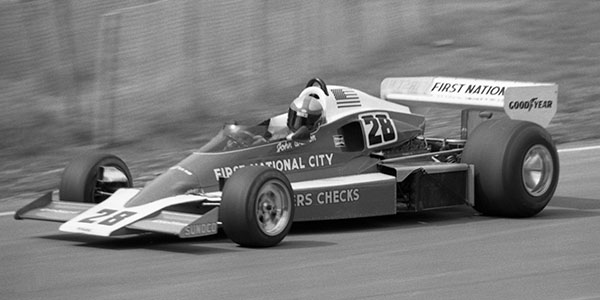Penske PC4 car-by-car histories

John Watson in the Penske PC4 at the 1976 British Grand Prix. Copyright David Bishop 2018. Used with permission.
Penske's final F1 car was a vast improvement, and John Watson took the Penske PC4 to a deserved victory at the Austrian Grand Prix in 1976. Just three months later, Penske withdrew from F1.
There was minimal pre-publicity for Geoff Ferris's latest design. Reports said that it went well in testing prior to the Swedish GP at Anderstorp, but when official practice began, John Watson encountered serious handling problems. A bad weekend got worse when the throttle stuck open on the first lap of the race and the car slammed into the catch-fencing. The regular journalists were unimpressed, Denis Jenkinson at Motor Sport dismissing it as a development of the Penske PC3. Pete Lyons at Autosport and Jabby Crombac at Sport Auto barely mentioned it at all. But with lower sidepods, a narrower front, inboard front suspension and finer attention to detail, the new design warranted more of a look.
Instead of the full-width March-style nose used on the PC3, the Penske PC4 initially had a nose similar to that on the latest Ferrari 312T2, with a full-width aerofoil mounted in front of the nosecone. After the accident demolished this, the car was rebuilt for the next race, the French, with a longer wheelbase and a more standard chisel nose with canard wings, as previously used on the PC3. After a spring was found to be a fraction of an inch too long, affecting cornering, Watson found the PC4 was transformed. He set the second-fastest time in the final practice session and qualified eighth on the grid. He excelled in the race too, finishing in third place. Although later disqualified from this race due to the rear wing being fractionally too high, he was subsequently reinstated. Another fine performance at the British Grand Prix ended in fourth place. The German GP weekend was ruined by a broken engine mount, but the team bounced back in Austria. In the opening session, Watson was second quickest behind James Hunt's McLaren M23 and started on the front row. The Ulsterman got to the first corner ahead of the McLaren and led – Penske's first F1 race lead. Rain began to fall, and Ronnie Peterson in his March 761 passed the Penske on lap 3. They were joined by Jody Scheckter in the Tyrrell P34, pushing the Penske back to third, but then the sun came out and the Penske became the faster car. Watson regained the lead on lap 12 and, on a rapidly drying track, pulled away to a very popular victory.
Watson was now a front runner, qualifying third at the Dutch GP and running second for most of the race until the gearbox failed. At the Italian GP, the Penske was disqualified again, this time the fuel used in practice being wrong. Forced to start from the back of the grid, Watson finished down in 11th. After only being a midfield runner in Canada, Watson added another point to his total at Watkins Glen by finishing sixth. This placed him equal sixth in the drivers' championship and put Penske into a tie for fourth in the constructors' race. The final race of 1976 was the Japanese GP, where Watson qualified fourth and ran second in the race briefly before the soaking wet track caused the Penske to lock up, and Watson aimed for the escape road. He resumed but retired later with engine trouble.
Race
Starts
Prix
Starts
Prix
Wins
And that was that. On Thursday 4 November, Roger Penske announced that he was withdrawing from F1 to concentrate on USAC and stock car racing. The Dorset factory would continue, and Geoff Ferris would soon be building the USAC Penske PC5, but the F1 cars were put up for sale. They were bought by the ATS Racing Team and entered for Jean-Pierre Jarier to race in 1977. Penske's former F1 team manager Heinz Hofer was on hand to advise at the first few races, and Derek Walker, who had been chief mechanic on the PC4s, spent time training up the ATS mechanics. The team started with some promise, but the performances faded away as the season wore on and as Jarier's enthusiasm for the project declined. The cars were then used to build the ATS HS1s in 1978.
A third PC4 was built by Penske for Interscope Racing in 1977, and then a third ATS HS1 was built from spares in 1978. One of the ex-Penske HS1s was converted back to Penske form for historic racing, and the ex-Interscope car was acquired by Penske for their museum. That leaves the other ex-Penske ATS still in HS1 form in historic racing, and the HS1 built from spares in a German collection.
These histories last updated on .